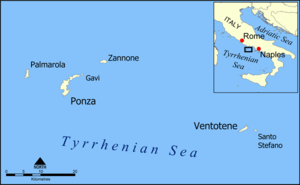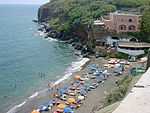Ventotene
| Ventotene | ||
|---|---|---|
| Comune | ||
| Comune di Ventotene | ||
 | ||
| ||
.svg.png) | ||
 Ventotene | ||
| Coordinates: 40°47′51″N 13°25′48″E / 40.79750°N 13.43000°ECoordinates: 40°47′51″N 13°25′48″E / 40.79750°N 13.43000°E | ||
| Country | Italy | |
| Region | Lazio | |
| Province | Latina (LT) | |
| Government | ||
| • Mayor | Giuseppe Assenso | |
| Area | ||
| • Total | 1.54 km2 (0.59 sq mi) | |
| Elevation | 18 m (59 ft) | |
| Population (30 April 2008) | ||
| • Total | 708 | |
| • Density | 460/km2 (1,200/sq mi) | |
| Demonym | Ventotenesi | |
| Time zone | CET (UTC+1) | |
| • Summer (DST) | CEST (UTC+2) | |
| Postal code | 04020 | |
| Dialing code | 0771 | |
| Patron saint | St. Candida | |
| Saint day | September 19 | |
| Website | Official website | |
Ventotene, in Roman times known as Pandataria or Pandateria from the Greek Pandoteira, is one of the Pontine Islands in the Tyrrhenian Sea, 25 nautical miles (46 km) off the coast of Gaeta right at the border between Lazio and Campania, Italy. The municipality of Ventotene, of the province of Latina (Lazio) has 708 permanent residents as of 2008.
Geography
The island, the remains of an ancient volcano,[1] is elongated, with a length of 3 kilometres (2 miles) and a maximum width of about 800 metres (2,625 feet).
The municipality includes the small ancillary island of Santo Stefano, located 2 km (1 mi) to the east, which is the site of a massive prison, now closed. A further island, Ponza, is 40 km (25 mi) to the west.
History
Pandataria is best known as the island to which the emperor Augustus banished his daughter Julia the Elder in 2 BC, as a reaction to her excessive adultery. Later, in 29 AD, emperor Tiberius banished Augustus' granddaughter Agrippina the Elder, [2] who perished, probably of malnutrition, on October 18, 33 AD. After Agrippina the Elder's son Gaius, (better known as Caligula), became emperor in 37 AD, he went to Pandataria to collect her remains and reverently brought them back to Rome. Agrippina the Elder's youngest daughter, Julia Livilla, was exiled to Pandateria twice: the first time by her brother Caligula for plotting to depose him, and second time by her uncle, the emperor Claudius, at the instigation of his wife, Messalina, in 41 AD. Sometime later, Julia Livilla was discreetly starved to death and her remains probably brought back to Rome when her older sister Agrippina the Younger became influential as Claudius' wife. Another distinguished lady of the Julio-Claudian dynasty, Claudia Octavia, who was the first wife of the emperor Nero, was banished to Pandateria in 62 AD and then executed on the orders of her husband.[3]
This is also the island to which St. Flavia Domitilla, the granddaughter of emperor Vespasian, was banished.
A prison camp was created under the Bourbons and restructured under Benito Mussolini on the nearby island of Santo Stefano. There, up to 700 opponents, including 400 communists, were incarcerated between 1939 and 1943. One of them was Altiero Spinelli who wrote there a text now known as the "Ventotene Manifesto", promoting the idea of a federal Europe after the war.
During World War II, the island served as home to a 114-manned German garrison who defended a key radar station. On the night of September 8, 1943, an American PT boat slipped into Ventotene's harbor undetected and offloaded 46 American paratroopers from the 509th Parachute Infantry Battalion. The paratroopers met with a local exile from the Italian mainland who then lied to the German commander that there was a regiment of paratroopers on the island, deposited by a fleet of Allied ships. Terrified, the German commander demolished his positions, weapons, and quickly surrendered to the weaker American force before realizing his mistake. Ventotene was liberated at 3 AM without a shot being fired.
Transport
The island is connected by ferry and hydrofoil service to Formia and Anzio; this is supplemented by summer services from and to Ischia.
Main sights
The port has kept some tuff structures of the ancient Roman structure; on the island are also remains of villas and the extensive rainwater catchment system of channels and cisterns hewn from the bedrock, for the island has no natural springs of fresh water, which today is shipped in by tanker.
In July 2009, archaeologists announced the discovery of a "graveyard" of five ancient Roman ships in the deep waters off Ventotene, with their pristine cargoes of olive oil, garum and metal ingots.[4][5] One ship carried a full load of a kind of dish called a mortarium, in which foods were ground or mashed.[6][7] Some of the recovered objects were immediately placed on view at Ventotene.
Gallery
-

Piazza Castello
-

Ventotene and the Pontine Islands
-

The island of Santo Stefano seen from Ventotene
-

Ventotene Beach
See also
References
- ↑ "Volcanic history of Ventotene". Annamaria Perrotta, Claudio Scarpati, Lisetta Giacomelli and Anna Rita Capozzi, "Proximal facies of a caldera forming eruption: the Parata Grande Tuff at Ventotene Island (Italy)." Journal of Volcanology and Geothermal Research 1996.
- ↑ Tacitus, The Annals 1.53
- ↑ Tacitus, The Annals 14.63-64
- ↑ "Ancient Roman shipwrecks found". BBC News. 24 July 2009. Retrieved 2010-11-19.
- ↑ "Lost Ships of Rome". Secrets of the Dead. PBS. November 15, 2010. Retrieved 2010-11-19.
- ↑ PBS, Lost Ships of Rome, viewed 2013-01-13.
- ↑ Romans in Sussex. How did the Romans prepare their food? Accessed 2013-01-13.
External links
| Wikimedia Commons has media related to Ventotene. |
- Ventotene official website
- ‘Tiny, charming island offers taste of pure Italy’, cnn.com/travel, October 6, 2008.
- Ventotene: An Island in The Global Herald, July 2011
